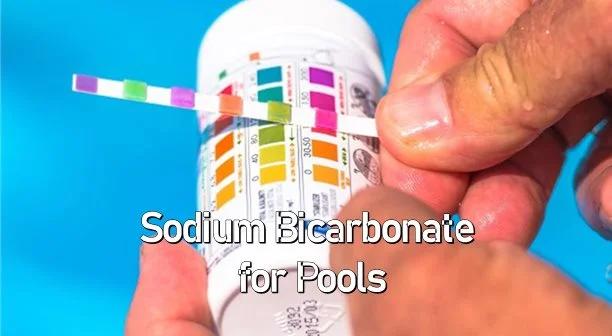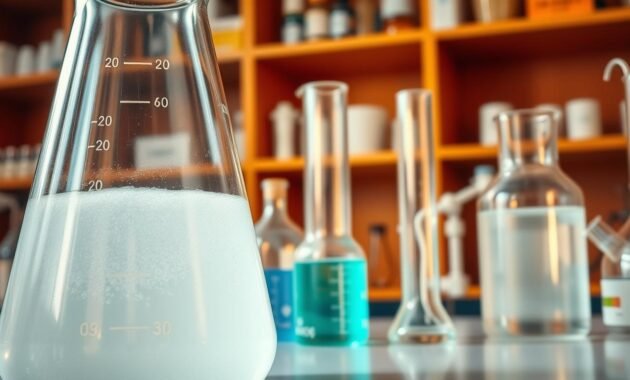Are you tired of murky, unstable pool water? It turns your backyard into a maintenance headache. Many pool owners face constant chemical imbalances, wasting time and money. Baking soda, or sodium bicarbonate, is a simple, affordable fix to improve your pool’s chemistry and clarity.
This white powder can be your secret weapon in pool care. It balances pH levels and prevents corrosion. Sodium bicarbonate for pools is a must-know for every owner. Get ready to enjoy clear water with little effort!

Understanding Pool Chemistry Basics and pH Levels
Keeping pool water healthy is all about chemical balance. As a pool owner, I’ve learned that the right water chemistry is key. It ensures swimmers are comfortable and equipment lasts longer. The balance of pH levels and alkalinity is critical.
Pool water chemistry might seem hard, but it’s simple once you know the basics. Let me explain the main elements that keep your pool perfect.
The Importance of Balanced Water Chemistry
Balanced pool water prevents many problems. It keeps swimmers happy and equipment working well. But, unbalanced pH levels can cause issues.
- Skin and eye irritation
- Damage to pool equipment
- Reduced effectiveness of sanitizing chemicals
- Potential corrosion of pool surfaces
Ideal pH Range for Swimming Pools
The perfect pH for pool water is between 7.2 and 7.6. This ensures swimmers are comfortable and chemicals work well. If pH levels get too far off, swimming can be uncomfortable and damage can occur.
| pH Level | Pool Water Condition | Potential Issues |
|---|---|---|
| Below 7.2 | Acidic | Corrosion, equipment damage |
| 7.2 – 7.6 | Ideal Range | Optimal swimming conditions |
| Above 7.6 | Alkaline | Scaling, reduced chemical efficiency |
Role of Total Alkalinity in Pool Maintenance
Total alkalinity helps keep pH levels stable. It should be between 80-120 parts per million (ppm). This range prevents sudden pH changes and keeps water balanced and comfortable.
Knowing these pool chemistry basics helps you keep your pool water perfect. It ensures a safe and fun swimming environment for everyone.
What Makes Sodium Bicarbonate Essential for Pool Care
As a pool owner, I’ve found sodium bicarbonate to be a game-changer. It keeps the water crystal-clear. This simple compound is key to maintaining a well-kept pool. It’s easier to use than complex chemicals.
Using sodium bicarbonate offers many benefits. It’s not just for one thing. It helps with several important aspects of pool water:
- Stabilizes pH levels effectively
- Increases total alkalinity
- Improves water clarity
- Prevents corrosion of pool equipment
Sodium bicarbonate’s magic comes from its unique properties. It’s also more affordable than many commercial products. Most pool experts recommend it for balancing water chemistry.
Read also: What is Alkalinity in a Pool?
| Property | Benefit for Pools |
|---|---|
| pH Balancing | Keeps water in optimal range (7.2-7.8) |
| Alkalinity Boost | Prevents rapid pH fluctuations |
| Cost-Effectiveness | Cheaper than specialized pool chemicals |
Sodium bicarbonate stands out because of its versatility. It’s a natural, safe choice for pool care. It works well for minor pH issues or improving water quality. Pool owners can rely on its consistent results.
Calculating the Right Amount of Sodium Bicarbonate for Your Pool
Getting the perfect alkalinity ph levels in your pool is all about precision. It’s not just a guess. It’s a science that keeps your pool’s water chemistry in check.
Before you start measuring, you need to know a few important things. Pool owners must consider several key factors for the best water balance.
Pool Size Considerations
The size of your pool is the first thing to think about. Different pool sizes need different amounts of baking soda to get the right alkalinity levels.
- Measure your pool’s total water volume accurately
- Calculate gallons using length × width × average depth
- Multiply total volume by 7.5 to get precise gallons
Testing Current Alkalinity Levels
Testing your pool’s chemistry is key. I suggest using a reliable digital pool testing kit to get accurate readings.
- Collect a water sample from mid-pool depth
- Follow kit instructions carefully
- Record current total alkalinity reading
Dosage Formula and Measurements
For pool maintenance, use 1.5 pounds of baking soda per 10,000 gallons of water. This usually raises alkalinity by about 10 parts per million (ppm).
| Pool Size | Baking Soda Amount | Alkalinity Increase |
|---|---|---|
| 10,000 gallons | 1.5 lbs | 10 ppm |
| 20,000 gallons | 3 lbs | 20 ppm |
Always add sodium bicarbonate slowly and test your water again. This careful approach is essential for your pool’s health.
Signs Your Pool Needs Sodium Bicarbonate Treatment
Keeping your pool healthy means watching the water chemistry closely. Spotting early signs can stop bigger problems before they start. Low alkalinity can lead to many issues, affecting water quality and equipment.
Look out for these key signs your pool might need sodium bicarbonate:
- Cloudy water appearance
- Visible corrosion on metal pool equipment
- Pitting or damage to pool liner and tiles
- Difficulty maintaining consistent pH levels
- Increased chlorine consumption
Cloudy water is a clear sign of a chemical imbalance. If your pool water is murky or not clear, check the alkalinity. Corrosion on metal parts means your water’s pH is too low and needs fixing fast.
| Symptom | Potential Alkalinity Issue | Recommended Action |
|---|---|---|
| Cloudy Water | Low Total Alkalinity | Add Sodium Bicarbonate |
| Metal Corrosion | Acidic Water Conditions | Balance pH and Alkalinity |
| Frequent Chemical Adjustments | Unstable Water Chemistry | Comprehensive Water Test |
I suggest testing the water regularly and watching your pool’s look closely. Catching and treating problems early can save you a lot of time and money on repairs.
Sodium Bicarbonate for Pools: Application Methods and Tips
Using sodium bicarbonate in pools needs care and skill. It keeps the water chemistry right and the pool clean. I’ll show you the best ways to use sodium bicarbonate for a clean swimming area.
Pre-Dissolution Process
Start by dissolving the sodium bicarbonate before adding it to your pool. This step stops clumps and spreads it evenly.
- Fill a clean bucket with pool water
- Slowly add sodium bicarbonate to the water
- Stir until completely dissolved
- Avoid adding dry powder directly to the pool
Distribution Techniques
Evenly spreading the solution is important. Use certain methods to cover the whole pool surface.
- Walk around the pool perimeter
- Pour the dissolved solution slowly
- Move in a consistent pattern
- Ensure complete pool coverage
Timing and Frequency of Application
Applying sodium bicarbonate at the right time is key. Do it when the weather is calm.
| Pool Type | Recommended Frequency | Best Time of Day |
|---|---|---|
| Residential Pool | Every 2-4 weeks | Early morning |
| Commercial Pool | Weekly | Before opening hours |
| Indoor Pool | Monthly | During maintenance |
By using these methods, you’ll keep your pool water perfect and your pool lasting longer.
Common Problems Solved by Sodium Bicarbonate

Keeping your pool clean can be tough, but sodium bicarbonate makes it easier. It’s a simple solution for many water problems. I’ve found that it can fix several common issues.
Cloudy water is a big problem for pool owners. But, sodium bicarbonate can make your water clear again. It does this by keeping the alkalinity levels stable.
- Eliminates green, blue, and yellow algae growth
- Prevents corrosion of pool equipment
- Reduces scaling buildup on pool surfaces
- Balances alkalinity levels for optimal water clarity
Now, let’s look at how sodium bicarbonate solves pool problems:
| Pool Problem | Sodium Bicarbonate Solution |
|---|---|
| Algae Growth | Stabilizes pH, creating hostile environment for algae |
| Equipment Corrosion | Protects metal surfaces by maintaining proper pH balance |
| Scaling Buildup | Prevents mineral deposits by regulating water chemistry |
| Cloudy Water | Clarifies water by adjusting alkalinity levels |
Sodium bicarbonate is a key tool for pool care. It fixes many problems, making it a smart and affordable choice. It helps keep your pool in great shape.
Safety Precautions When Using Pool Chemicals
Keeping your swimming pool safe is key. Sodium bicarbonate pools are mostly safe, but handling chemicals right is important. It keeps you safe and helps keep the pool in good shape.
When you’re working with pool chemicals, your safety comes first. Always wear the right safety gear. This helps avoid accidents and keeps you safe from chemicals.
Essential Protective Equipment
- Chemical-resistant safety glasses
- Long rubber gloves
- Protective clothing that covers arms and legs
- Closed-toe shoes
- Respirator mask for powdered chemicals
Storage Guidelines for Pool Chemicals
Storing pool chemicals right is important. It stops dangerous reactions and keeps them working well. Here’s how to store them:
- Keep chemicals in a cool, dry place
- Store in original containers with tight-fitting lids
- Separate different types of chemicals
- Keep out of reach of children and pets
- Avoid storing near heat sources or direct sunlight
Safe Handling Practices
When you’re working with pool chemicals, follow these safety tips:
- Never mix different pool chemicals
- Add chemicals to water, not water to chemicals
- Work in a well-ventilated area
- Wash hands thoroughly after handling chemicals
- Read and follow manufacturer instructions carefully
By following these safety steps, you can keep your pool safe. And you’ll protect yourself and your family too.
Cost Benefits of Using Sodium Bicarbonate vs Commercial Products
Keeping a swimming pool clean can be pricey. But, I found a way to save money using sodium bicarbonate. Baking soda is a cheaper choice than commercial pool chemicals. It helps pool owners save a lot of money during the swimming season.
Let’s look at how sodium bicarbonate compares to special pool products:
| Product Type | Average Cost per Pound | Annual Savings |
|---|---|---|
| Commercial Alkalinity Increaser | $12-$18 | Base Price |
| Baking Soda (Sodium Bicarbonate) | $1-$3 | Up to 80% Savings |
Using sodium bicarbonate for pools has more benefits than just saving money:
- Pure, food-grade ingredient
- Readily available at grocery stores
- Effective pH and alkalinity balancer
- Safe for swimmers and pool equipment
While commercial products might be easier to find, baking soda is just as good and much cheaper. By learning how to use it right, you can manage your pool’s chemistry well. And, you’ll keep more cash in your wallet.
Maintaining Optimal Pool Chemistry Year-Round
Keeping your pool’s chemistry balanced is a year-round job. As a pool owner, I’ve learned that it’s not just a summer task. It’s a commitment all year.
Different seasons bring unique challenges to pool water chemistry. Summer’s high usage and temperatures can change your pool’s balance. Winter months need a special approach to prevent stagnation and damage.
- Summer: More frequent testing of ph levels
- Winter: Reduced chemical activity but requires monitoring
- Spring/Fall: Transitional periods needing careful chemical adjustments
To keep your pool in top shape, I suggest a strategic approach to managing alkalinity levels:
- Test water chemistry every two weeks
- Use sodium bicarbonate for quick pH and alkalinity corrections
- Adjust chemical treatments based on seasonal changes
Ideal ranges stay the same all year: keep ph levels between 7.2 and 7.8. Also, keep alkalinity levels between 110 and 150 parts per million. By being proactive and understanding your pool’s needs, you’ll have clear water and great swimming conditions all year.
Troubleshooting Pool Chemical Imbalances
Keeping pool water chemistry balanced can be tough, even for experts. Imbalances can pop up fast, affecting swimmers and equipment. Knowing how to spot and fix these problems is key to a safe, fun pool.

Monitoring pool water chemistry is vital. pH levels are key to water quality and comfort. If the water gets out of balance, you’ll see warning signs that need quick action.
Identifying Chemical Warning Signs
- Cloudy or discolored pool water
- Unusual chlorine odors
- Skin or eye irritation after swimming
- Scale buildup on pool surfaces
- Persistent algae growth
pH Level Diagnostic Chart
| pH Level | Water Condition | Potential Issues |
|---|---|---|
| Below 7.0 | Acidic | Corrosive to equipment, skin irritation |
| 7.0 – 7.4 | Slightly Acidic | Reduced chlorine effectiveness |
| 7.5 – 7.8 | Ideal Range | Optimal swimming conditions |
| Above 8.0 | Alkaline | Scale formation, cloudy water |
Corrective Strategies
Act fast if you spot chemical imbalances in your pool. First, test your pool’s pH levels with reliable tools. Sodium bicarbonate can help stabilize pH and fix the water chemistry.
- Test pool water thoroughly
- Identify specific chemical imbalances
- Calculate the correct chemical adjustment
- Add chemicals gradually
- Retest water after treatment
Regular care and watching your pool closely can prevent big chemical problems. By being proactive and knowing your pool’s chemistry, you can keep it safe and fun for everyone.
Alternative pH and Alkalinity Adjusters
Sodium bicarbonate is a common choice for pool owners. But, there are other options for managing alkalinity pH levels. Knowing these alternatives can help you make better choices for your pool’s water chemistry.
Soda ash is a strong alternative to sodium bicarbonate. It has a higher pH range, from 11.3 to 11.7. This makes it more effective at raising alkalinity levels. The main differences between soda ash and sodium bicarbonate are:
- Effectiveness in raising pH levels
- Cost considerations
- Specific pool chemistry needs
Borax is another option for pool maintenance. It helps stabilize pH levels with less dramatic changes. Pool owners should consider these alternatives based on their water chemistry needs:
- Soda ash (sodium carbonate)
- Borax (sodium borate)
- Muriatic acid for pH reduction
- Calcium carbonate
It’s wise to talk to a pool chemistry expert. They can help find the best alkalinity adjuster for your pool. Each option has its own benefits and can affect your pool’s water balance and maintenance.
Read also: How to Neutralize Muriatic Acid
Conclusion
Managing your swimming pool’s chemistry can seem complex, but sodium bicarbonate offers an affordable and effective solution. I’ve learned that understanding how to use this powerful pool treatment can transform your maintenance routine. It keeps water balanced and crystal clear.
Throughout our exploration of sodium bicarbonate pools, we’ve discovered its incredible versatility. It adjusts pH levels and prevents corrosion, acting as a game-changer for pool owners. The key is consistent testing, precise application, and a proactive approach to water chemistry.
By implementing the strategies we’ve discussed, you can protect your pool’s infrastructure, enhance swimmer comfort, and reduce long-term maintenance costs. Remember that every swimming pool is unique, so always take time to understand your specific water conditions before adding sodium bicarbonate.
Your pool represents an investment in summer enjoyment and relaxation. With the right knowledge and tools, you can create a pristine aquatic environment. It welcomes family and friends for countless memorable moments.


